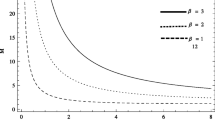Abstract
A model describing the internal microstates of particles is used to calculate the statistical entropy of a Schwarzschild black hole. The state of the system is described by a nonextensive entropy function which is superadditive and so fails to be concave. A strict maximum of the entropy does not exist; nonetheless, the entropy increases on merging two such systems.
Similar content being viewed by others
References
P. T. Landsberg,J. Stat. Phys. 35:159 (1984) and references therein.
M. Alexanian,Phys. Rev. D 4:2432 (1971).
M. Alexanian,Phys. Rev. D 26:3743 (1982).
S. K. Bose,An Introduction to General Relativity (Wiley Eastern Ltd., New Delhi, 1980).
S. W. Hawking,Commun. Math. Phys. 43:199 (1975).
W. H. Zurek,Phys. Rev. Lett. 49:1683 (1982); D. N. Page,Phys. Rev. Lett. 50:1013 (1983).
J. D. Bekenstein,Phys. Rev. D 23:287 (1981).
D. Ruelle,Statistical Mechanics: Rigorous Results (W. A. Benjamin, Inc., New York, 1969).
Author information
Authors and Affiliations
Rights and permissions
About this article
Cite this article
Alexanian, M. Statistical entropy of a Schwarzschild black hole. J Stat Phys 41, 709–717 (1985). https://doi.org/10.1007/BF01009029
Received:
Revised:
Issue Date:
DOI: https://doi.org/10.1007/BF01009029



